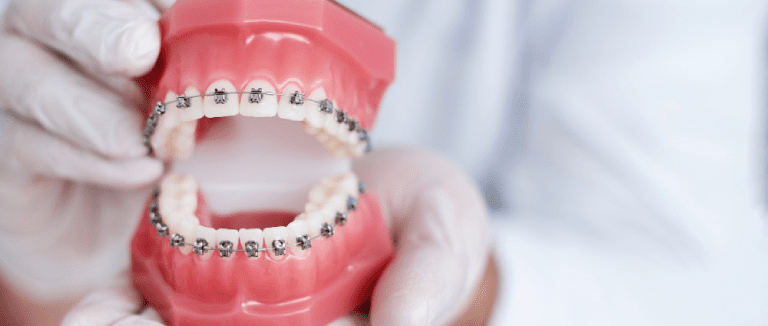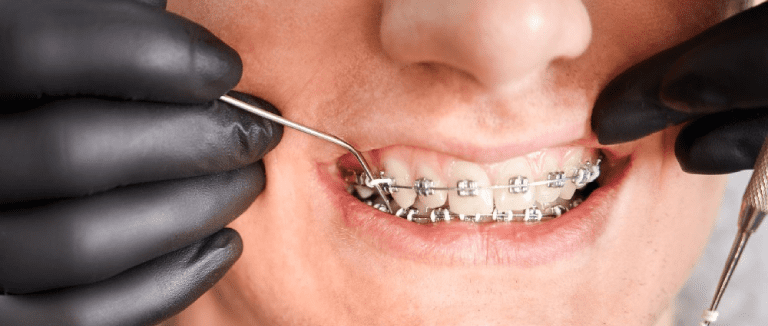The Importance of Orthodontics in Achieving a Healthy Smile
Having teeth that are properly aligned significantly impacts oral health, it mean "orthodontics". The way your upper and lower teeth fit together is called "occlusion." When this alignment is poor, it's known as malocclusion. Treating malocclusion can help prevent oral health problems such as cavities, gum disease, and excessive tooth wear.

Ortodontics: What Is It?
Orthodontics is a specialized field of dentistry that involves the diagnosis, prevention, and correction of misaligned teeth, jaw irregularities, and improperly aligned bite patterns. It also encompasses the modification of facial growth.
Positional abnormalities of teeth and jaws are quite common. Therefore, many people benefit from orthodontic treatment, and patients who have completed treatment often report an improvement in their quality of life.
The duration of orthodontic treatment can vary from several months to several years. The length of treatment needed for teeth and jaws depends on the disorders present, the patient's oral and dental health, and their age. During this process, an orthodontist may use braces and similar appliances to gradually adjust tooth positions and jaw alignment. In cases where malocclusion, or poor bite, is severe, surgical intervention may be included in the treatment plan.
What Does Orthodontics Mean?
Orthodontics is a dental specialty. The word comes from the Greek terms "ortho, meaning straight or correct, and "odont, meaning tooth. As the name suggests, orthodontics focuses on properly aligning the teeth in the mouth and diagnosing and treating irregularities related to the teeth, jaws, and facial structure.

Orthodontic Treatment: What Is It?
Orthodontic treatment may sometimes increase the risk of tooth decay and gum problems. Therefore, an orthodontist may expect the patient to have good oral hygiene before starting treatment.
An orthodontist may use braces to correct the position of the teeth. Braces, which are one of the most commonly used orthodontic appliances, work to straighten teeth through the use of an external wire attached to the teeth. Although this process can be uncomfortable at times, it is frequently chosen by patients and orthodontists because it achieves the desired outcome.
Furthermore, an orthodontist may employ mechanical devices or perform maneuvers related to the jaw. In some cases, the patient may need to wear headgear or have temporary screws placed in their jaw. The exact treatment approach is determined based on the dental issue present.
If teeth are overcrowded and braces are required, an orthodontist may recommend the extraction of some teeth, even if they are healthy.
The duration of treatment generally depends on the complexity of the cases. Roughly speaking, orthodontic treatment lasts between 6 and 30 months. After the process is completed, retainers may be placed in the patient's mouth to prevent the teeth from returning to their original position. Retainers are not removable like braces and help maintain the alignment of the teeth. Sometimes, after the braces are removed, the patient may need to wear a type of removable retainer.
These types of retainers can be taken out and put back in, unlike other treatment methods. It is generally recommended to use them for at least 12 months. The use of retainers varies from case to case. Therefore, if you have any questions about how to use retainers after orthodontic treatment, you can consult your orthodontist.

Benefits and Process of Orthodontic Treatment:
- Straightened teeth enhance chewing efficiency and improve speech clarity.
- Misaligned teeth are more likely to trap food particles, increasing the risk of tooth decay. Orthodontic treatment helps prevent this by correcting teeth alignment.
- Malocclusions can increase the likelihood of gum injury and trauma, but orthodontic treatment reduces this risk by improving bite alignment.
- Properly aligned teeth make it significantly easier to maintain good oral hygiene.
- Orthodontic treatment can help relieve pain associated with temporomandibular joint (TMJ) disorders by correcting bite alignment.
- Orthodontic treatment results in a healthier and more attractive smile.
- By enhancing their smile and appearance, orthodontic treatment can boost an individual's confidence.
Patients play a vital role in the orthodontic process, which is a long-term commitment extending beyond routine office visits. Active participation and adherence to the orthodontist's instructions are crucial for achieving the best results. While orthodontic interventions”such as braces”can cause initial discomfort, most patients find that this subsides over time as they adjust to the treatment. Following professional guidance throughout the process is essential for maintaining dental health and ensuring treatment success.

What to Know About Orthodontic Treatment:
Orthodontic treatment can be used to address many issues, and patients can benefit from orthodontics in various ways. For example:
- Correcting dental misalignments,
- Straightening teeth,
- Correcting malocclusion (poor bite),
- Reducing the risk of damage to protruding teeth, are some of the benefits.
In orthodontic treatment, sometimes the shape of the face affected by the abnormal position of the patient's teeth and jaw can be corrected. Additionally, it can also help correct other health issues such as cleft lip and palate.
A common complication of orthodontic treatment is white spots on the teeth. These spots can occur when plaque builds up on the patient's teeth and around the braces, producing acid and indicating early tooth decay. To prevent such issues and reduce the risk of tooth decay, orthodontists may recommend high-fluoride toothpaste or fluoride-containing mouthwash for patients. Additionally, avoiding sugary foods and carbonated drinks during orthodontic treatment is often advised.
* Liv Hospital Editorial Board has contributed to the publication of this content .
* Contents of this page is for informational purposes only. Please consult your doctor for diagnosis and treatment. The content of this page does not include information on medicinal health care at Liv Hospital .
For more information about our academic and training initiatives, visit Liv Hospital Academy
Frequently Asked Questions
How long does orthodontic treatment take?
The duration varies depending on the case, typically between 6 and 30 months. Factors such as the severity of misalignment, patient age, and oral hygiene habits influence the overall timeline.
What are the side effects of orthodontic treatment?
The most common issue is an increased risk of cavities due to plaque buildup around braces. Other temporary effects can include mild discomfort, tooth sensitivity, and gum irritation. Maintaining good oral hygiene helps minimize these risks.
What age is best for orthodontic treatment?
Orthodontic treatment can be effective at almost any age. However, the ideal time to begin is typically between ages 10 and 14 when teeth and jaws are still developing. Adults can also benefit from orthodontic care with modern, discreet options.
Is orthodontic treatment painful?
Mild discomfort or pressure may occur after braces are tightened or new aligners are fitted, but this usually subsides within a few days as the mouth adjusts.
Do I need tooth extractions before orthodontic treatment?
In cases of severe crowding, an orthodontist may recommend removing one or more teeth to create sufficient space for alignment.
How should I care for my teeth during orthodontic treatment?
Brush after every meal using a soft-bristled toothbrush, floss daily with orthodontic floss, and use fluoride mouthwash to protect against cavities. Avoid sticky or hard foods that can damage braces or aligners.
What are retainers, and why are they important?
Retainers maintain teeth alignment after braces are removed. They prevent teeth from shifting back to their original positions. Depending on the case, they may be fixed or removable.
Can orthodontic treatment fix jaw problems?
Yes. Orthodontic treatment can correct bite misalignments (malocclusion) and, in some cases, help with jaw position and facial symmetry.
Where can I receive orthodontic treatment in Türkiye?
Liv Hospital in Istanbul offers advanced orthodontic care with traditional braces, Invisalign, and lingual techniques, providing comfortable and effective solutions for children and adults alike.


